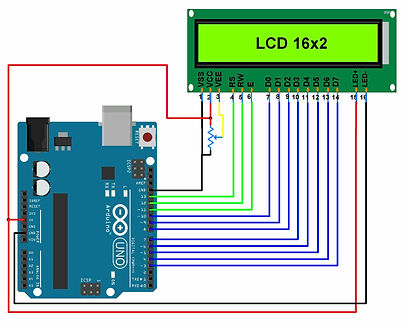
What to do with an unprecedented LCD display?
Antoon PE1IVX sent me an email asking if I could help him.
He had been given some large displays but wasn't sure how to get them to work.
They are phico Do 94v-0 P68C displays. 18 cm long, 4cm wide. Green in color and a black border. Characters from 10mm to 6mm. Yellow backlight.
Antoon sent me 2 so I could test something.
I did not immediately find the correct information on the internet.
Then I found this link http://www.datavision.com.tw/en/lcm_01_1.php?P_Id=20
After studying this info it should be easy to get the screen working.(I thought)
Everything indicated that this screen works like the small classic 2x16 lines screens.
Said so done. Screen was connected according to the classic 4bit mode.
But no luck. The screen stayed off.
Checked all wires and found no errors.
Then searched the internet for a few hours for info.
Suddenly I found an answer to a question and which OM claimed that such screens need a negative voltage to get contrast.
The reason for this is that these screens have a very large temperature field in which they can be used.
But negative voltage is not coming from my power supply. aha a 9V battery might work. The plus to the arduino ground and the minus to the potentiometer.
And yes it worked. I had contrast but no text yet.
Back on a quest on the internet. In all the examples you will find , the displays are used in 4bit mode.
Finally, I decided to connect the display in 8bit mode.
I found an article explaining how to change the software.
After adjusting I suddenly got legible text.
The testing was very instructive. Learned something again.
Such screens were also used in the telephones in the public payphones.
Large and easy to read.
The test program:
#include <LiquidCrystal.h>
// initialize the library by associating any needed LCD interface pin
// with the arduino pin number it is connected to
const int RS = 12, AND = 11, D0 = 10, D1 = 9, D2 = 8, D3 = 7 , D4 = 6, D5 = 5, D6 = 4, D7 = 3;
LiquidCrystal LCD(RS, EN, D0, D1, D2, D3, D4, D5, D6, D7); // 8-bit mode
void setup() {
// set up the LCD's number of columns and rows:
lcd.begin(20, 2);
// Print a message to the LCD.
lcd.print("Jean-Marie , ON7EN");
}
void loop() {
// set the cursor to column 0, line 1
// (note: line 1 is the second row, since counting begins with 0):
lcd.setCursor(0, 1);
// print the number of seconds since reset:
lcd.print(millis() / 1000);
}


